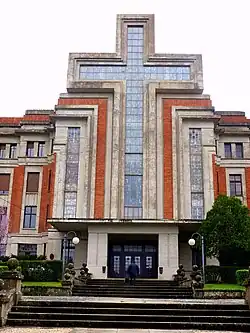| Seminary of Pamplona | |
|---|---|
 | |
| Alternative names | Seminario Conciliar de San Miguel |
| General information | |
| Town or city | Pamplona |
| Inaugurated | 1931 |
| Height | |
| Architectural | Expressionist architecture |
| Design and construction | |
| Architect(s) | Víctor Eusa Razquin |
The Seminary of Pamplona (in Spanish, Seminario Conciliar de San Miguel) is the catholic seminary of that city, opened in 1931 and designed by the architect Víctor Eusa Razquin.
It is a work from the most expressionist period in Eusa, characterized, as in the Church of La Milagrosa, by the combination of white concrete and red brick, a style that has been defined as déco-expressionism or geometric expressionism.[1] [2]
The feature that stands out in the building is the colossal cross that constitutes the main façade, which has also been defined as futurist. It is said to have been inspired by fellow expressionist Spanish architect Casto Fernandez-Shaw,[3] who projected a cathedral / skyscraper building named "Cruz soñada" (dreamt cross) that was never built.[4]
References
- ↑ Alejos, Nerea (25 April 2022). "Víctor Eusa: arquitectura para bailar". Diario de Navarra. Retrieved 25 May 2023.
- ↑ Tabuenca, Fernando (1999). "La arquitectura de Víctor Eusa: La forma continua" (PDF). Revista Arquitectura (318): 26–35. Retrieved 25 May 2023.
- ↑ Pérez Moreno, Lucía C.; Martínez Litago, Elena (2019). "La revista Nueva Forma y la cultura arquitectónica y artística vasco-navarra (1966-75)". Revista Arquitectura (15(2)): 408–424. Retrieved 25 May 2023.
- ↑ COAM (1970). "Proyecto de rascacielos por Casto Fernandez-Shaw" (PDF). Revista Arquitectura (189): 8–9. Retrieved 25 May 2023.